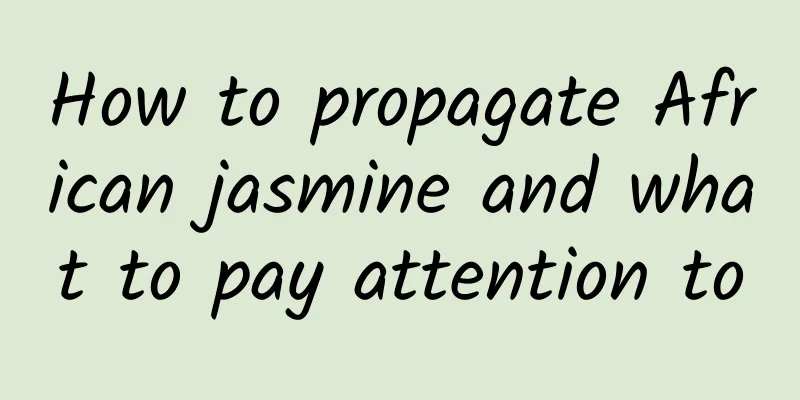How to propagate African jasmine and what to pay attention to

African jasmine reproduction methodThere are four main ways to propagate African jasmine: cuttings, division, sowing and layering. Its seeds can also be propagated, and its natural reproduction method is also seed propagation. Generally speaking, African jasmine is propagated fastest by cuttings. African jasmine breeding timeThe specific time for the reproduction of African jasmine to achieve a high survival rate depends on the method of reproduction. For example, if it is division reproduction, it is suitable to be carried out in March and April in spring, and if it is cutting reproduction, it is best to be carried out in June and July, with a high survival rate. African Jasmine Propagation MethodPropagation of African jasmine by divisionRemove the African jasmine from the pot, remove some of the soil on the roots, and then use a sharp knife to cut the weak points of the plant's roots. Each clump should have at least 2-3 stems and a part of the root system that is intact, and then plant them in pots separately. African jasmine cutting propagationCut 1-2 year old healthy African jasmine branches as cuttings. The cuttings should be 12-15 cm long, with 2 to 3 and a half leaves. The lower incision should be located 0.2-0.3 cm below the node. Plant them in peat soil, then cover the plants with plastic film to keep them moist. When the weather is clear, pay attention to proper shade. They will take root in 1-2 months. African jasmine seed propagationFirst, germinate the seeds of African jasmine, then sow them directly on loose and fertile sandy loam, cover them with a thickness of 2-3 cm, and cover them with a layer of plastic wrap to keep warm to promote germination as soon as possible. African Jasmine Breeding Tips1. Division propagation is a relatively simple method of propagation for African jasmine. However, during the division process, try to avoid too many wounds on the root system to avoid affecting future growth. 2. If African jasmine is sown and propagated in late autumn and early winter, it will generally take until the spring of the following year for seedlings to emerge. After emergence, remove the plastic wrap in time, and pay attention to strengthening water and fertilizer management, and pay attention to timely shading after summer. |
<<: Preparation and use of peanut fertilizer
>>: Preparation and use of osmanthus fertilizer
Recommend
How to prune Kalanchoe after it blooms
1. Time Selection After the flowers have bloomed,...
Time and method of cuttings of Fraxinus chinensis
Cutting time of Fraxinus chinensis Fraxinus chine...
How to take care of newly bought peonies
1. Temperature Peony flowers prefer shade and hat...
How to pot the Meiguanlan
1. Basic Preparation We usually choose March-Apri...
Cutting propagation method of laurel
Cutting time of red back osmanthus Cuttings can b...
Cultivation methods and precautions of Basoglossum
How to cultivate Basoglossum illumination Bractea...
Cultivation methods and precautions of Prunus mume
Habits of Prunus mume Prunus mume prefers plenty ...
Can green jade chrysanthemum be cultivated hydroponically?
Can green jade chrysanthemum be cultivated hydrop...
Does lavender prefer shade or sun? Does lavender need sunlight?
1. Do you prefer shade or sun? Lavender loves the...
What is the best month to plant grape seedlings and when is the best time to transplant them?
Which month is suitable for planting grape seedli...
Medium-leaf chive planting time and method
Leek is a very common vegetable in our lives and ...
What is the value of African ice grass
Edible value of African ice grass African ice gra...
How to grow plant curtains? Do this and it’ll be done in a month!
Bead curtains Buddha beads, also known as pearl s...
Why does the summer azalea bloom in spring?
1. Why do flowers bloom in spring? Xia Juan is al...
Salvia miltiorrhiza planting conditions and growth environment requirements
Introduction to Salvia miltiorrhiza Salvia miltio...









